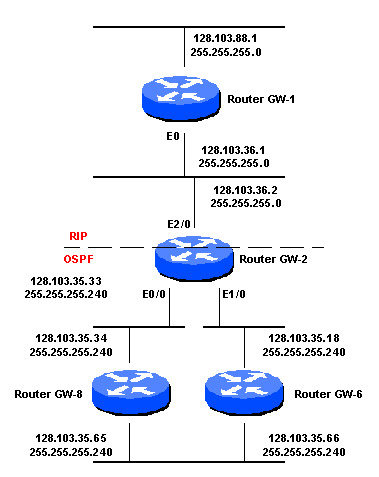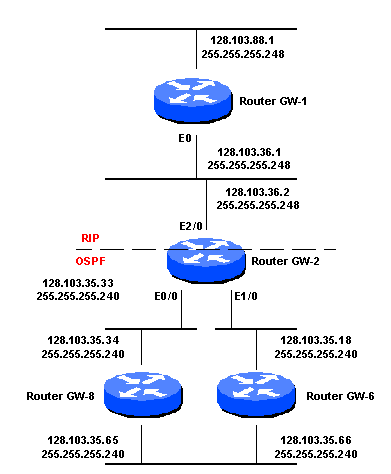Redistributing Between Classful and Classless Protocols: EIGRP or OSPF into RIP or IGRP
Available Languages
Contents
Introduction
This document explains two common problems with redistributing routes between RIP and OSPF or IGRP and EIGRP. RIP and IGRP will not advertise routes out an interface if those routes are on the same major network, but have a different mask than that particular interface. For more information on RIP and IGRP updates, refer to Behavior of RIP and IGRP When Sending and Receiving Updates.
Prerequisites
Requirements
There are no specific requirements for this document.
Components Used
This document is not restricted to specific software and hardware versions.
The information presented in this document was created from devices in a specific lab environment. All of the devices used in this document started with a cleared (default) configuration. If you are working in a live network, ensure that you understand the potential impact of any command before using it.
Conventions
For more information on document conventions, refer to Cisco Technical Tips Conventions.
OSPF Has a Longer Mask Than RIP
In the network diagram for this problem, Router GW-2 is redistributing between RIP and OSPF. The OSPF domain has a different mask (longer in this case) than the RIP domain, and they are on the same major network. Therefore, RIP will not advertise routes learned from OSPF and redistributed into RIP.

Solution
The subnet mask of the OSPF domain is difficult to change, so instead, add a static route in Router GW-2 that points to the OSPF domain with a mask of 255.255.255.0, but with a next hop of null0. Then, redistribute static routes into RIP. Here is the configuration to accomplish this task:
ip route 128.103.35.0 255.255.255.0 null0 router rip redistribute static default metric 1
This allows 128.103.35.0 to be advertised through RIP out the E2/0 interface of Router GW-2. However, Router GW-2 still has more specific routes learned from OSPF in its routing table, so the best routing decisions are made.
RIP Has a Longer Mask Than OSPF
In the network diagram for this problem, the RIP domain has a mask of 255.255.255.248 and OSPF domain has a mask of 255.255.255.240. RIP will not advertise routes learned from OSPF and redistributed into RIP.

Solution
We can add a static route in Router GW-2 that points to the OSPF domain with a mask of 255.255.255.248. However, because this is a more specific mask than the original OSPF mask, the next hop must be an actual next hop or interface(s). Also, we need multiple static routes in order to cover all of the addresses in the OSPF domain. This way static routes are redistributed into RIP.
In the code below, the first two static routes cover the range 128.103.35.32 255.255.255.240 in the OSPF domain. The second two static routes cover the range 128.103.35.16 255.255.255.240 in the OSPF domain. And the last four static routes cover the range 128.130.35.64 255.255.255.240, which are known via two interfaces in the OSPF domain.
ip route 128.103.35.32 255.255.255.248 E0/0 ip route 128.103.35.40 255.255.255.248 E0/0 ip route 128.103.35.16 255.255.255.248 E1/0 ip route 128.103.35.24 255.255.255.248 E1/0 ip route 128.103.35.64 255.255.255.248 128.103.35.34 ip route 128.103.35.64 255.255.255.248 128.103.35.18 ip route 128.103.35.72 255.255.255.248 128.103.35.34 ip route 128.103.35.72 255.255.255.248 128.103.35.18 router rip redistribute static default metric 1
Conclusion
The solutions presented in this document also work when you use EIGRP instead of OSPF, and IGRP instead of RIP. This problem should not happen if the masks of both protocols are the same or if all the protocols you use support Variable Length Subnet Mask (VLSM). This fix is only considered a patch to cover the RIP and IGRP (VLSM) limitation. For more information on the RIP and IGRP VLSM limitation, refer to Why Don't RIP and IGRP Support VLSM?.
 Feedback
Feedback